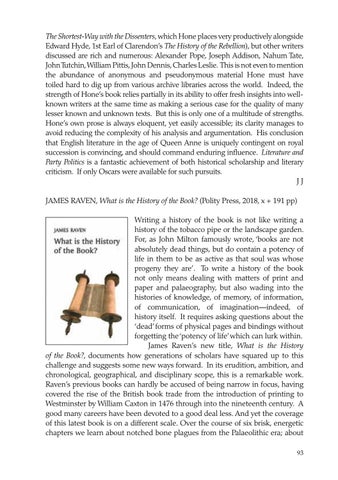The Shortest-Way with the Dissenters, which Hone places very productively alongside Edward Hyde, 1st Earl of Clarendon’s The History of the Rebellion), but other writers discussed are rich and numerous: Alexander Pope, Joseph Addison, Nahum Tate, John Tutchin, William Pittis, John Dennis, Charles Leslie. This is not even to mention the abundance of anonymous and pseudonymous material Hone must have toiled hard to dig up from various archive libraries across the world. Indeed, the strength of Hone’s book relies partially in its ability to offer fresh insights into wellknown writers at the same time as making a serious case for the quality of many lesser known and unknown texts. But this is only one of a multitude of strengths. Hone’s own prose is always eloquent, yet easily accessible; its clarity manages to avoid reducing the complexity of his analysis and argumentation. His conclusion that English literature in the age of Queen Anne is uniquely contingent on royal succession is convincing, and should command enduring influence. Literature and Party Politics is a fantastic achievement of both historical scholarship and literary criticism. If only Oscars were available for such pursuits. JJ JAMES RAVEN, What is the History of the Book? (Polity Press, 2018, x + 191 pp) Writing a history of the book is not like writing a history of the tobacco pipe or the landscape garden. For, as John Milton famously wrote, ‘books are not absolutely dead things, but do contain a potency of life in them to be as active as that soul was whose progeny they are’. To write a history of the book not only means dealing with matters of print and paper and palaeography, but also wading into the histories of knowledge, of memory, of information, of communication, of imagination—indeed, of history itself. It requires asking questions about the ‘dead’ forms of physical pages and bindings without forgetting the ‘potency of life’ which can lurk within. James Raven’s new title, What is the History of the Book?, documents how generations of scholars have squared up to this challenge and suggests some new ways forward. In its erudition, ambition, and chronological, geographical, and disciplinary scope, this is a remarkable work. Raven’s previous books can hardly be accused of being narrow in focus, having covered the rise of the British book trade from the introduction of printing to Westminster by William Caxton in 1476 through into the nineteenth century. A good many careers have been devoted to a good deal less. And yet the coverage of this latest book is on a different scale. Over the course of six brisk, energetic chapters we learn about notched bone plagues from the Palaeolithic era; about 93
Magdalene College Magazine No.63 2018-19

Issuu converts static files into: digital portfolios, online yearbooks, online catalogs, digital photo albums and more. Sign up and create your flipbook.














